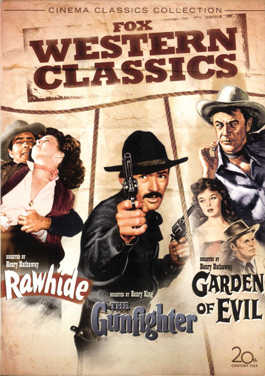home | metro silicon valley index | movies | current reviews | dvd review

Fox Western Classics
Three discs; 20th Century Fox; $19.98
By Michael S. Gant
This three-fer is a real bargain that proves there's more to Westerns than John Wayne. In Garden of Evil (1954), three Gold Rush adventurers end up stranded on the coast of Mexico: Hooker (Cary Cooper), a laconic ex-sheriff; Fiske (Richard Widmark), a glib card shark; and Luke (Carmeron Mitchell), a young hothead. Hanging out in the local cantina (and listening to a very young Rita Moreno), they encounter Leah (Susan Hayward), who hires them to travel inland to save her husband, who is trapped in a gold mine. Days of hard riding follow, until they arrive at an abandoned village buried in the lava from a volcano. After rescuing the husband (Hugh Marlowe), the men lust after Leah and fight their way past attacking Apaches (who have strayed way, way out of their range). Henry Hathaway's epic was an early CinemaScope feature and takes great advantage of some fabulous settings in Michoacán. Husky-voiced Hayward (a real pain on the shoot, according to an interview with Hathaway) acts with her hair—and what hair it is, full, free-flowing, deep auburn and impervious to jungle humidity. The meat of the movie comes in the various discussions about how a man should act in the face of temptation—greed for gold and greed for a woman. After many bitter recriminations, Marlowe's character makes a tortured sacrifice to save his dignity. Meanwhile, Cooper and Widmark trade truisms about the masculine code. Cooper on attention to duty: "Somebody's got to stay. Somewhere in the world, somebody has to get it done." Near the end, comes the summa theologica of the American Western: "It doesn't matter what a man says, only what he does." The extras include lots of juicy gossip about the location shoot, especially Hayward's need to run off for a quick tryst with Howard Hughes. Rawhide (1951 and no relation to the TV show), also directed by Hathaway, stars a miscast Tyrone Power, who looks too old to be the hapless second-in-command at a lonely stagecoach way station. He and traveler Susan Hayward (with an infant in arms) are held hostage by sensitive robber Hugh Marlowe and his psycho sidekicks (including a drooling Jack Elam). The action—or lack thereof—takes place in and around the one set. Gorgeous black-and-white images by cinematographer Milton R. Krasner make up for the static premise—Power and Hayward spend nearly half an hour clawing a hole in an adobe wall. An excellent extra discusses the history of location shooting in Lone Pine on the eastern side of the Sierra, where Rawhide was made. The Gunfighter (1950), by Henry King, suffers from the same inertia as Rawhide. After a nifty duel at the beginning, world-weary fast-drawer Jimmy Ringo (Gregory Peck in a droopy mustache and shapeless hat) spends the rest of the movie moping around the town where his wife (Helen Wescott) teaches school and raises the boy he's never met. Everyone is gunning for him, the fate of all gun slingers who live too long. Again, superb cinematography (by deep-focus master Arthur Miller) rides to the rescue. Look for Karl Malden as the mercenary barkeep. All three discs come with copious supplemental material, including fascinating behind-the-scenes interviews.
Send a letter to the editor about this story.
|
|
|
|
|
|
